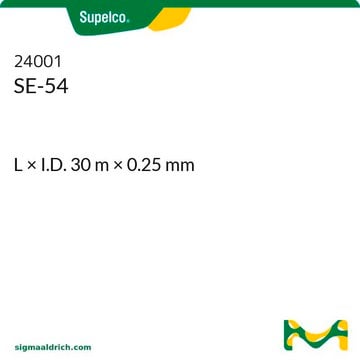25351
SPB®-5 Capillary GC Column
L × I.D. 60 m × 0.53 mm, df 5.00 μm
Sign Into View Organizational & Contract Pricing
All Photos(1)
About This Item
UNSPSC Code:
41115710
eCl@ss:
32119290
Recommended Products
material
fused silica
Agency
meets requirements for USP G27 and G36
parameter
-60-260 °C temperature (isothermal)
-60-280 °C temperature (programmed)
Beta value
27
df
5.00 μm
technique(s)
gas chromatography (GC): suitable
L × I.D.
60 m × 0.53 mm
matrix active group
Bonded; poly(5% diphenyl/95% dimethyl siloxane) phase
column type
capillary non-polar
Looking for similar products? Visit Product Comparison Guide
General description
Capillary GC column is also known as open tubular column. The carrier gas flows through the central aperture and is unrestricted throughout the length of the column.
Application: This non-polar general purpose column provides primarily a boiling point elution order with a slight increase in selectivity, especially for aromatic compounds.
USP Code: This column meets USP G27 and G36 requirements.
Phase:
USP Code: This column meets USP G27 and G36 requirements.
Phase:
- Bonded
- Poly(5% diphenyl/95% dimethyl siloxane)
- ≤0.32 mm I.D., <2 μm: -60 °C to 320 °C (isothermal or programmed)
- ≤0.32 mm I.D., ≥2 μm: -60 °C to 300 °C (isothermal or programmed)
- ≥0.53 mm I.D., <2 μm: -60 °C to 300 °C (isothermal) or 320 °C (programmed)
- ≥0.53 mm I.D., ≥2 μm: -60 °C to 260 °C (isothermal) or 280 °C (programmed)
Application
SPB®-5 Capillary GC Column was used for speciation of the nitrogen compounds (quantitatively), which are polar and somewhat basic in nature, with chemiluminescence detection. It may be used as stationary phase for determination of nivalenol and deoxynivalenol in cereals by electron-capture gas chromatography. It may also find application in being used as stationary phase in capillary column gas chromatography for determination of sterols.
Other Notes
We offer a variety of chromatography accessories including analytical syringes
Legal Information
SPB is a registered trademark of Merck KGaA, Darmstadt, Germany
Storage Class Code
11 - Combustible Solids
WGK
WGK 3
Flash Point(F)
Not applicable
Flash Point(C)
Not applicable
Choose from one of the most recent versions:
Already Own This Product?
Find documentation for the products that you have recently purchased in the Document Library.
Determination of nivalenol and deoxynivalenol in cereals by electron-capture gas chromatography
SCott PM
Journal - Association of Official Analytical Chemists, 889-893 (1985)
Á Kenéz et al.
Journal of dairy science, 102(12), 11718-11729 (2019-09-30)
Adipose tissue response to endocrine stimuli, such as insulin, is crucial for metabolic adaptation at the onset of lactation in dairy cows. However, the exact molecular mechanisms behind this response are not well understood. Thus, the aim of this study
V Gajdůsková et al.
Veterinarni medicina, 37(8), 471-478 (1992-08-01)
Occurrence of individual polychlorinated biphenyl (PCB) congeners in the environment, foodstuffs and other biological materials was assessed. Analysis of specific PCB congeners (28, 52, 101, 138, 153, 180), occurring in animal raw materials and foodstuffs most frequently, has been implemented.
Development of a passive sampler to measure personal exposure to gaseous PAHs in community settings.
Zhihua Fan et al.
Environmental science & technology, 40(19), 6051-6057 (2006-10-21)
A sensitive, simple, and cost-effective passive sampling methodology was developed to quantify personal exposure to gaseous polycyclic aromatic hydrocarbons (PAHs). A Fan-Lioy passive PAH sampler (FL-PPS) is constructed from 320 sections of 1-cm long SPB-5 GC columns (0.75-mm i.d. and
J M Jurado et al.
Talanta, 106, 14-19 (2013-04-20)
4-Methylsterols and 4,4-dimethylsterols of 47 samples of subcutaneous fat from Iberian pigs reared on two different fattening systems, "Extensive" and "Intensive", have been analyzed by GC-MS and GC-FID. The lipids were extracted by melting the subcutaneous fat in a microwave
Our team of scientists has experience in all areas of research including Life Science, Material Science, Chemical Synthesis, Chromatography, Analytical and many others.
Contact Technical Service




